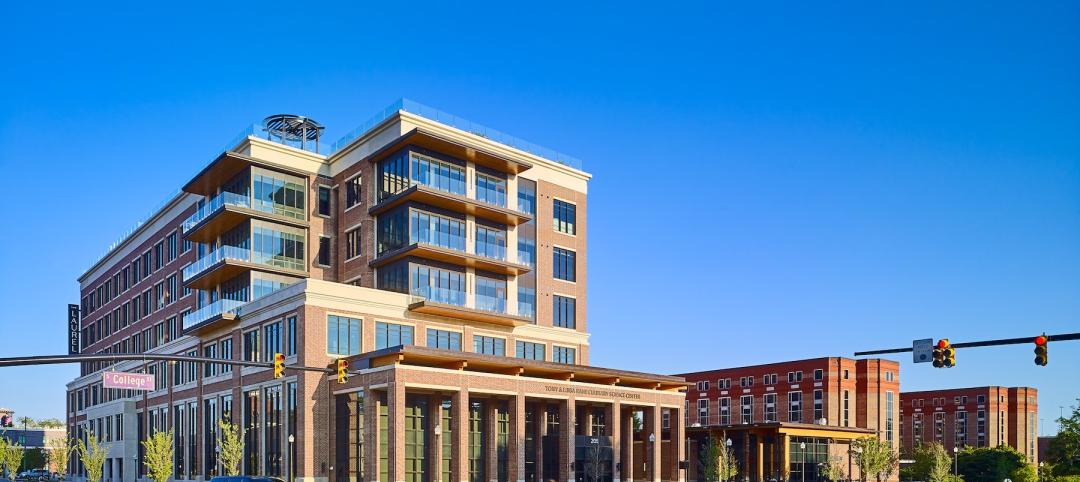Over a five-day stretch last December, students at the Carroll School in Lincoln, Mass., witnessed the installation of a modular classroom building like no other.
The new 950-sf structure, which will serve as the school's tutoring offices for the next few years, is loaded with sustainable features like sun-tunnel skylights, doubled-insulated low-e glazing, a cool roof, light shelves, bamboo trim, low-VOC materials, daylight and occupancy sensors, and a quiet, high-efficiency ventilation system.
The relocatable classroom, named SmartSpace by its creators, is one of a number of high-performance modular classrooms to emerge on the market during the last few years, and it's the first LEED-level unit to be installed in the U.S.
“With SmartSpace, we wanted to rethink typical modular design and construction approaches for classroom buildings,” says Mark N. Dolny, AIA, senior associate with ARC/Architectural Resources Cambridge, which teamed with modular manufacturer NRB Inc., Ephrata, Pa., and Littleton, Mass.-based modular leasing company Triumph Leasing Corp. to develop the SmartSpace design.
Dolny says simple additions like a double-door entry vestibule and expansive exterior glazing (6x16 feet) go a long way toward reducing energy consumption and improving the interior classroom environment.
“Most modular classrooms don't have vestibules, so conditioned air instantly leaks out when people come and go,” says Dolny. A recent energy study of SmartSpace conducted by The Hickory Consortium, Harvard, Mass., confirms the team's theory on the importance of vestibules: “It was one of the biggest factors in the energy study,” says Dolny, adding that the unit beat Massachusetts state energy code by 56% during testing.
The SmartSpace team was careful to keep the concept “realistic and reasonable” as it pertains to first cost, shipping logistics, and constructability, according to Philip L. Laird, AIA, principal with ARC, who collaborated on the design.
“We wanted to make sure this was a doable project and not just a pretty poster that got stuck in a drawer somewhere,” says Laird. “The solution had to be something that NRB could easily build in its shop and ship to the site.”
To that point, the design team worked closely with NRB and Triumph to stay within the size constraints and material specifications for a typical modular classroom. Common materials such as corrugated steel siding, medium-density fiberboard walls, and TPO roofing were specified over more complicated, labor-intensive solutions, like vegetated roofing. Also, dimensions were limited to 25 feet wide, 38 feet long, and 15 feet high to ease shipping to the site and installation. The building is shipped in two pieces. Once connected, the structure is strong enough to permit relocation of the classroom in one piece.
The team also excluded exotic technologies like solar and wind power for fear that school districts would balk at the higher first cost.
“We played with the idea of taking the building completely off the grid with photovoltaics, but PVs are still an expensive technology,” says Dolny. The fact that many modular classrooms are leased works against solar and wind power, he says. “If school districts are leasing, they don't have a 20-year payback to work with, and they can't get tax credits or grants to help pay for the systems.”
Project FROG makes leaps in California
In California, another high-performance modular classroom venture, Project FROG (BD+C May 2006, p. 9), is making inroads of its own.
The company is working on its first installation, a 9,500-sf child development center at the City College of San Francisco, to be completed this summer. The development will incorporate 10 of the firm's Dragonfly and Turtle “green” modular units interconnected to form a campus with classrooms, work areas, office space, reading rooms, a preschool, and motor skills areas for both preschoolers and toddlers.
Project FROG spokesperson Nikki Tankursley says the company is in talks with several other colleges about building similar child development centers. “We've also gotten calls from major Silicon Valley corporations looking to build child development centers for their employees,” says Tankursley. “I think we're on to a nice market here.”
In addition, the company received news late last month that its modular units are now “pre-check” approved by the Division of the State Architect. That means that school districts and community colleges that wish to install Project FROG modules will get expedited permitting and approvals from the DSA.
“Having DSA PC approval tells administrators these buildings meet tough structural, life safety, and environmental standards,” said Leela Gill, COO with Project FROG, a collaboration between San Francisco-based design firm MKThink and B&H Engineering, a San Carlos, Calif.-based manufacturing firm.
The company's modular units, which range in size from 1,000 sf to 1,700 sf, also meet the high-performance school requirements of California's Collaborative for High Performance Schools program, exceed the state's Title 24 energy requirements, and are LEED certifiable. Green features include abundant daylight (up to 800 sf of glass in a single module), T5 or T8 high-efficiency fluorescent lighting, occupancy and daylight sensors, recycled acoustical ceiling tiles with a minimum NRC of 0.60, no-VOC carpet, and recycled rubber flooring.
Related Stories
University Buildings | Nov 13, 2022
University of Washington opens mass timber business school building
Founders Hall at the University of Washington Foster School of Business, the first mass timber building at Seattle campus of Univ. of Washington, was recently completed. The 84,800-sf building creates a new hub for community, entrepreneurship, and innovation, according the project’s design architect LMN Architects.
University Buildings | Nov 2, 2022
New Univ. of Calif. Riverside business school building will support hybrid learning
A design-build partnership of Moore Ruble Yudell and McCarthy Building Companies will collaborate on a new business school building at the University of California at Riverside.
School Construction | Oct 31, 2022
Claremont McKenna College science center will foster integrated disciplinary research
The design of the Robert Day Sciences Center at Claremont McKenna College will support “a powerful, multi-disciplinary, computational approach to the grand socio-scientific challenges and opportunities of our time—gene, brain, and climate,” says Hiram E. Chodosh, college president.
University Buildings | Oct 27, 2022
The Collaboratory Building will expand the University of Florida’s School of Design, Construction, and Planning
Design firm Brooks + Scarpa recently broke ground on a new addition to the University of Florida’s School of Design, Construction, and Planning (DCP).
Higher Education | Oct 24, 2022
Wellesley College science complex modernizes facility while preserving architectural heritage
A recently completed expansion and renovation of Wellesley College’s science complex yielded a modernized structure for 21st century STEM education while preserving important historical features.
BAS and Security | Oct 19, 2022
The biggest cybersecurity threats in commercial real estate, and how to mitigate them
Coleman Wolf, Senior Security Systems Consultant with global engineering firm ESD, outlines the top-three cybersecurity threats to commercial and institutional building owners and property managers, and offers advice on how to deter and defend against hackers.
University Buildings | Oct 7, 2022
Auburn’s new culinary center provides real-world education
The six-story building integrates academic and revenue-generating elements.
K-12 Schools | Sep 21, 2022
Architecture that invites everyone to dance
If “diversity” is being invited to the party in education facilities, “inclusivity” is being asked to dance, writes Emily Pierson-Brown, People Culture Manager with Perkins Eastman.
University Buildings | Sep 9, 2022
Alan Schlossberg, AIA, LEED AP, joins DesignGroup’s Pittsburgh studio as Regional Practice Leader
Alan Schlossberg, AIA, LEED AP, has joined DesignGroup as a principal of the firm and regional practice leader.
| Sep 2, 2022
New UMass Medical School building enables expanded medical class sizes, research labs
A new nine-story, 350,000 sf biomedical research and education facility under construction at the University of Massachusetts Chan Medical School in Worcester, Mass., will accommodate larger class sizes and extensive lab space.
















